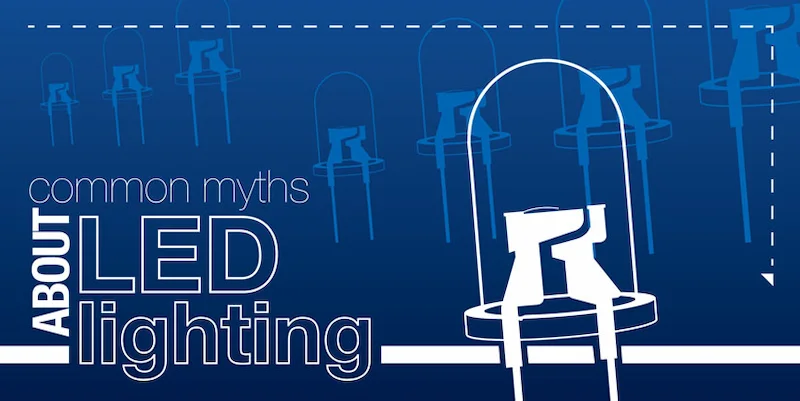
Mr. Electric debunks common myths about LED bulbs, clarifying their benefits and performance.
|
Low-energy LED lighting technology is the wave of the future. Are you still in the dark? Let us help you separate the facts from the hype surrounding this increasingly popular lighting option.
LEDs Last Forever
How long do LED bulbs really last? Like all light sources, LEDs will fade slowly over time Depending on operating conditions, well-designed fixtures can retain 70 percent of their initial light output for 6 years, or 50,000 hours or more. If you run them 24/7, they'll last you twice as long as fluorescents and many times longer than incandescents.
LED Bulbs are Expensive
The total cost of LED lighting over time can be significantly lower than conventional systems. Though initial fixture costs may be higher, LED fixtures have a longer useful life, are more durable and reliable requiring less maintenance and material costs, and use far less energy than their fluorescent and incandescent cousins. Annual lighting costs can be reduced by up to 80 percent, and payback on your investment can often be achieved in less than three years.
I Should Wait for LED Pricing to Decline before Investing in This Lighting Technology
Waiting will cost you more in the long run. Lighting is often one of the greatest energy expenses of a business. Incremental price declines in LED technology will be more than offset by paybacks in energy savings. It does not pay to wait.
LED Lighting Technology Is Too New
LED bulbs have been in widespread use for over a decade. LEDs have earned their place as a reliable lighting technology, having been used in critical safety applications and rapidly gaining popularity for industrial use thanks to their cost effective, efficient, sustainable, high-quality light. Their impressive durability makes them a top choice for high intensity industrial applications such as manufacturing operations, warehousing, maintenance, and more.
LEDs Contain Mercury
LED lighting does not contain mercury. However, fluorescents and compact fluorescents (CFLs) contain hazardous mercury. Not only are the mercury-free, but LEB bulbs only generate about half the heat of their counterparts and produce a limited amount of UV radiation.
LED Bulbs Are Not Bright Enough for Industrial Applications
Thanks to advancements in technology, LEDs are ideal for these applications. A wide range of fixtures - from low to high lumen outputs - are available today, allowing for the selection of lighting perfectly matched to suit your specific business needs. Placement is essential to proper optics, so be sure to consult a professional to plan effective light placement.
LED Light Is Too Blue
LED lighting is "cooler" than other lighting colors. The blue hue of LEDs does vary from the yellow tones of traditional lighting. However, customers frequently cite an improvement in lighting quality and effectiveness following upgrades. If you have concerns, consider another hue in the ever-expanding variety of LED colors now available.
LEDs Offer Poor Dimming Capabilities
Well-designed LEDs offer convenient, targeted dimming settings. Quality matters. Well-designed LEDs can provide gradual dimming across many more increment than their competitors, offering targeted settings for the perfect combination of convenience, ambiance and energy savings. While LED bulbs do not require a special dimmer, you will need to purchase dimmable LED bulbs that are compatible with traditional dimmer or upgrade your dimmer switches.
The Magnetic Ballasts in LEDs Require Service and Replacement
LED bulbs don't use magnetic ballasts - they use electronic drivers. Well-designed drivers don't require replacement. Light bulbs, like incandescent, fluorescents, and halides, use magnetic ballasts that wear out over time, particularly with frequent on and off switching. LEDs do not share these characteristics because LEDs are semiconductors, not light bulbs. They require electronic drivers for managing power delivery. Look for electronic drivers with well-designed, integrated control features for the maximum in efficiency and functionalities - like dimming, sensing, and auto on and off capability.
LED Lighting Does Not Work Well in High Temperature Environments
Well-designed LEDs function beautifully in a wide range of temperatures. LEDs performed at least as well as fluorescents and HIDs in temperature tests conducted by independent labs, particularly in cold environments where other lighting technology suffers. However, quality matters. Opt for lighting that is carefully designed to manage heat dissipation - regardless of the climate you will operate them in.
LEDs Are Too Bright for High-Intensity Applications
Well-designed LED bulbs manage glare and light placement with optics, which minimizes a direct sightline to LEDs, as well as glare, and color temperature for these applications is also excellent.
Don't let old lighting technology leave your business burned out. Upgrade to LED lighting with the help of Mr. Electric® today.
Need a home service expert? Visit Neighborly.com.

